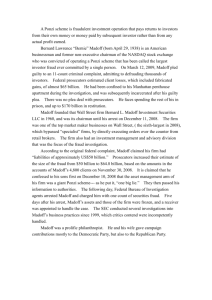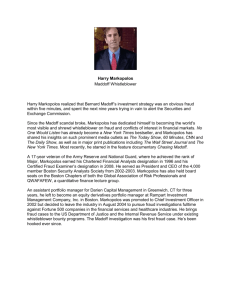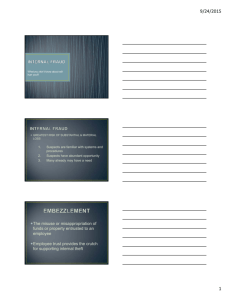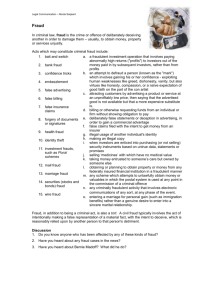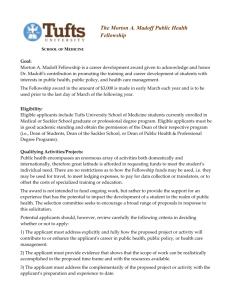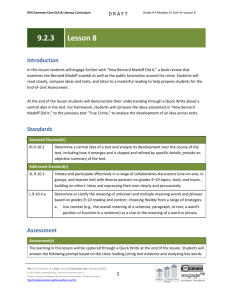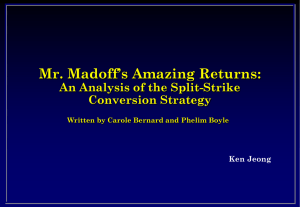Article PDF - Institute for Advanced Studies in Culture
advertisement
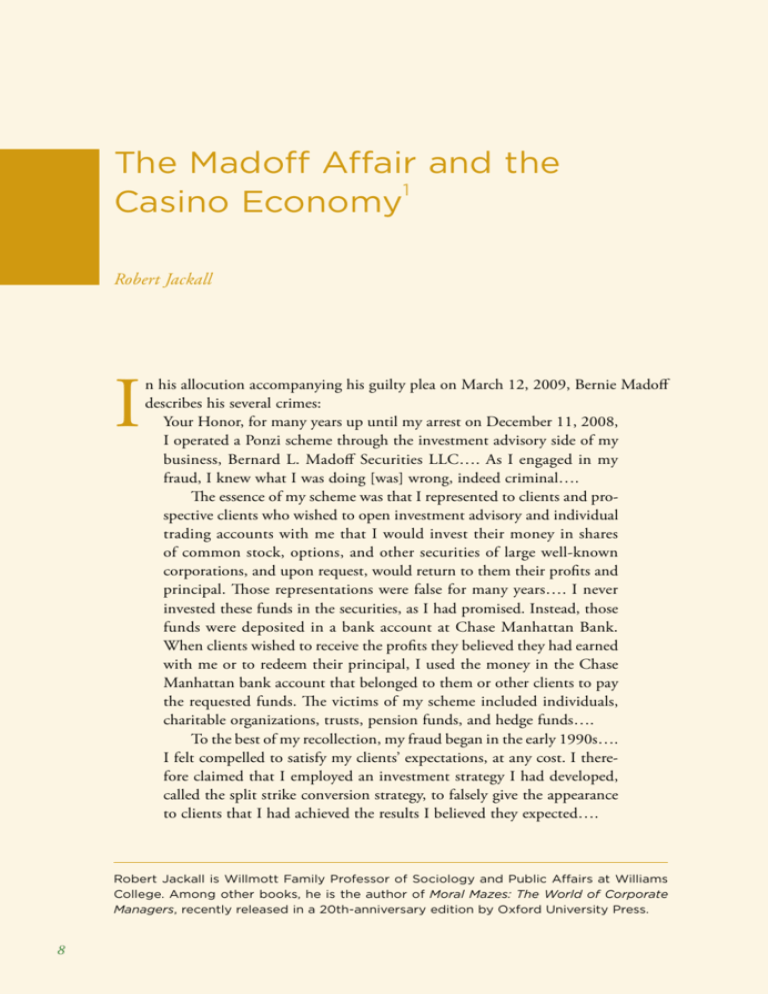
The Madoff Affair and the 1 Casino Economy Robert Jackall I n his allocution accompanying his guilty plea on March 12, 2009, Bernie Madoff describes his several crimes: Your Honor, for many years up until my arrest on December 11, 2008, I operated a Ponzi scheme through the investment advisory side of my business, Bernard L. Madoff Securities LLC…. As I engaged in my fraud, I knew what I was doing [was] wrong, indeed criminal…. The essence of my scheme was that I represented to clients and prospective clients who wished to open investment advisory and individual trading accounts with me that I would invest their money in shares of common stock, options, and other securities of large well-known corporations, and upon request, would return to them their profits and principal. Those representations were false for many years…. I never invested these funds in the securities, as I had promised. Instead, those funds were deposited in a bank account at Chase Manhattan Bank. When clients wished to receive the profits they believed they had earned with me or to redeem their principal, I used the money in the Chase Manhattan bank account that belonged to them or other clients to pay the requested funds. The victims of my scheme included individuals, charitable organizations, trusts, pension funds, and hedge funds…. To the best of my recollection, my fraud began in the early 1990s…. I felt compelled to satisfy my clients’ expectations, at any cost. I therefore claimed that I employed an investment strategy I had developed, called the split strike conversion strategy, to falsely give the appearance to clients that I had achieved the results I believed they expected…. Robert Jackall is Willmott Family Professor of Sociology and Public Affairs at Williams College. Among other books, he is the author of Moral Mazes: The World of Corporate Managers, recently released in a 20th-anniversary edition by Oxford University Press. 8 © Illustration by Aggie Kenny/Stringer/Getty Images T he madoff A ffair and the casino economy / jackall In this courtroom artist rendering, Financier Bernard Madoff discusses his crimes with Judge Denny Chin in a Manhattan federal court on March 12, 2009, in New York City. Madoff was ordered to jail after pleading guilty to a multibillion-dollar financial fraud scheme. In fact, I never made those investments I promised clients…. To conceal my fraud, I misrepresented to clients, employees, and others that I purchased securities for clients in overseas markets…. I knowingly gave false testimony under oath to the staff of the SEC [Securities and Exchange Commission]…. I knowingly caused false trading confirmations and client account statements that reflected the bogus transactions and positions to be created and sent to clients…. I [also] concealed my fraud through the filing of false and misleading certified audit reports and financial statements…. I wired money between the United States and the United Kingdom to make it appear as though there were actual securities transactions executed on behalf of my investment advisory clients…. In connection with the purported trades, I caused the fraudulent investment advisory side of my business to charge the investment advisory clients four cents per share as a commission.2 Madoff’s fraud took money from 339 funds in forty countries. The total economic damage to his victims is estimated at about $65 billion. This does not include lost opportunity costs or the costs of rebuilding institutions and networks shattered by his fraud. And it does not include the emotional costs of the public exposure of the naivete that made his scam possible. 9 T he H edgehog R e v iew / S ummer 2 0 1 0 * Madoff’s competitors were frustrated and baffled by his extraordinary reported returns in both up and down markets. Some of them were also deeply suspicious. In 1999, Harry Markopolos, then working as a hedge fund manager in Boston, assembled a team of top analysts at his boss’s behest to attempt to replicate the returns generated by Madoff’s purported “split-strike conversion strategy.”3 When the team failed to come even close to Madoff’s numbers after several tries, Markopolos submitted his findings, and his consequent suspicions, to the Boston office of the Securities and Exchange Commission in May 2000. A year later, two different investigative journalists published highly skeptical articles about Madoff, both of which were widely read by the generals and soldiers of the financial industry.4 One of the articles asked pointedly how it was possible for Madoff to buy and sell stocks in the huge quantities necessary to post the returns he advertised with no effect whatsoever on the overall market. In October 2001, Markopolos resubmitted his May 2000 report to SEC’s Boston office, complete with additional data and an explanation of the investment process Madoff was presumably using. Neither of Markopolos’s reports led to any substantive SEC action on the Madoff matter. While traveling on a marketing trip to London, Paris, Geneva, and Zurich in June 2002, Markopolos discovered that “high-born” Europeans, including members of royal families, were heavily invested with Bernard L. Madoff Securities LLC.5 Then, in June 2005, Markopolos and the rest of the financial community learned that Madoff was trying to borrow Markopolos’s memorandum money from European banks, a sure sign that his firm was running short of cash and having trouble meetdiscounted the scenario that ing redemption demands from clients.6 In November Madoff Securities was engaged 2005, at the urging of the boss of SEC’s Boston office, Markopolos submitted a detailed memorandum to in “front-running customer the New York office of the SEC.7 After describing order flow,”…he argued that how he collected materials from extensive first-hand conversations with investors in Madoff’s fund and Madoff was running “the with senior managers on Wall Street’s equity derivaworld’s largest Ponzi scheme.” tives trading desks, Markopolos listed 29 red flags about irregularities in Madoff’s operation. Among other things, the red flags pointed to: Madoff’s highly secretive and unusual business organization, with only Madoff family members privy to the firm’s investment strategies; Madoff’s funding his operations at the equivalent of a 16 percent interest rate, far higher than other Wall Street firms that borrow in shortterm credit markets at much lower rates, but then subject themselves to rigorous scrutiny; Madoff’s unheard of string of successes, specifically only 7 small stated monthly losses in more than 14 years with reported 12 percent annual net returns to clients, profits that required a gross yield of at least 16 percent; Madoff’s subsidization of clients’ losses in big down months; Madoff’s perfect market-timing ability that enabled him to go to 100 percent cash ahead of 2 major market declines in July 1998 and December 10 © Shaun Curry/AFP/Getty Images T he madoff A ffair and the casino economy / jackall A copy of the London Evening Standard's front page is pictured against the entrance to the London office of Madoff Securities International in London, on December 15, 2008. 1999; and Madoff’s refusal to allow performance audits by anyone except his brotherin-law’s accounting firm, on the argument that such secrecy protected proprietary trading strategies. Markopolos’s memorandum discounted the scenario that Madoff Securities was engaged in “front-running customer order flow,” a form of insider trading where brokers buy ahead of their clients the same stocks their clients wish purchased. Instead, in November 2005, he argued that Madoff was running “the world’s largest Ponzi scheme.” The New York office of the SEC did not pursue with any vigor the investigative leads that Markopolos provided. The assigned team thought the submission had little value because Markopolos was not an aggrieved investor with Madoff and was not personally involved in the purported Ponzi scheme and therefore did not have first-hand personal knowledge of any fraud. This SEC examination focused on whether Madoff was more than the broker-dealer he claimed to be, that is, a financial professional who “makes markets” and earns money by charging commissions on all transactions he executes and by trading on his own accounts. In the end, the SEC attorneys thought Madoff should also register as an investment adviser, that is, as a financial professional who makes money principally by managing others’ assets for a fee. They did not focus on Markopolos’s lead that Madoff was running a giant pyramid racket. This formal-rules-and-procedures thinking typified the habits of mind of SEC’s staff at the time. If Madoff “registered” as an investment adviser, he “would have to keep all the books and records that are required under Section 204 of the Advisers Act. He would have to have a compliance program, and he would be subject to an examination by our IA [Investment Adviser] team.”8 Madoff did, in fact, register as an investment 11 T he H edgehog R e v iew / S ummer 2 0 1 0 adviser, but, as it happened, the SEC’s unit that investigates investment advisers never conducted an examination after his registration. One sees another instance of this reliance on formal rules and procedures when SEC Chairman Christopher Cox received an anonymous letter in December 2006 saying that “assets well in excess of $10 billion owned by the late Norman F. Levy…have been ‘co-mingled’ with funds controlled by the Madoff company with gains thereon retained by Madoff.” Cox handed the matter over to subordinates who called Madoff’s lawyer and were told by him that Madoff had not managed any money for Levy, a representation that the subordinates quickly accepted precisely because it came from an attorney. All the while, Madoff was plundering Levy’s assets and those of Levy’s charity foundation JEHT: Justice, Equality, Human Dignity and Tolerance, which was forced to close in January 2009. Levy considered Madoff one of his closest confidants and friends.9 In June and July 2007, Markopolos sent more materials to the SEC about Madoff’s operation, each raising more “giant” red flags. For instance, Markopolos emailed an SEC officer on June 28, 2007, as follows, sending her some documents about a financial firm that invested with Madoff: Attached are some very troubling documents that show the Madoff fraud scheme is gettng [sic] even more brazen…. Madoff couldn’t possibly be managing the billions in this strategy unlevered [sic], much less levered [sic]. I thought you would want to see these…documents. When Madoff finally does blow up, it’s going to be spectacular, and lead to massive selling by hedge funds, fund of funds as they face investor redemptions.10 But the SEC did nothing. It is important to note that Markopolos also sent all of his SEC submissions and other materials to an investigative journalist at the Wall Street Journal, who promised to pursue the issue. But the Journal also did nothing on the story until Madoff’s world collapsed in December 2008, when he could not meet the flood tide of cash redemption demands from his investors and feeder funds as the global economy plunged into the Great Recession. * Madoff worked his massive fraud for nearly two decades even though many financial professionals around the world knew or strongly suspected that his operations were shady at best.11 The moral rule-in-use in the financial world is to look the other way unless one’s own interests are directly at stake. Some financial professionals simply advised their own firms’ risk managers that it was past time to stay away from Madoff. Others benefited from Madoff’s fraud, such as those who managed feeder funds and put moneys with Madoff to make quick returns, did so, and got out whole. Some investors assumed that Madoff was “front-running” and were quite happy with that illegal tactic as long as their handsome returns continued. If these men and women had suspicions, they suppressed them, part of the knowing and not-knowing consciousness widespread in compartmented bureaucratic societies. For many, fear of Madoff’s reputation and power underlay the reluctance to report misgivings about his operations. Madoff was in the inner circle of men who created the NASDAQ Stock Market, and he chaired that market’s board of directors. He sat 12 T he madoff A ffair and the casino economy / jackall on the board of governors of the National Association of Security Dealers (NASD) and participated in many NASD committees. He was a founder of the London-based International Securities Clearing Corporation. Peter B. Madoff, brother of Bernard, was vice chairman of the NASD, sat on its board of governors, and chaired its New York regional chapter. He was on the NASDAQ board of governors and its executive committee, and chaired NASD’s trading committee. In addition, he sat on the board of directors of the Security Traders Association of New York and on the board of the Depository Trust Corporation. Peter Madoff was also an attorney and the Chief Compliance Officer of Bernard L. Madoff Investment Securities LLC. The Madoff web site trumpeted the firm’s integrity. In an era of faceless organizations owned by other equally faceless organizations, Bernard L. Madoff Investment Securities LLC harks back to an earlier era in the financial world: The owner’s name is on the door…. Clients know that Bernard Madoff has a personal interest in maintaining the unblemished record of value, fair-dealing, and high ethical standards that has always been the firm’s hallmark.12 In short, the Madoff family wielded remarkable power in the financial world and was not reluctant to use that power to reward friends and punish enemies. In such a world, silence becomes judicious prudence. Regulatory jurisdiction of the financial industry resembles a checkerboard with impassable moats around each square. The SEC, the Commodity Futures Trading Commission (CFTC), the Federal Reserve (FED), the Federal Trade Commission (FTC), the Department of the Treasury, and the Department of Justice are only some of the federal agencies with jurisdiction over aspects of the financial markets. There are also state regulators such as the New York Attorney General (NYAG) and the Massachusetts Securities Division (MSD) that play crucial roles in those important states’ markets. There is also the non-governmental Financial Industry Regulatory Authority (FINRA), formed in July 2007 by consolidation of the NASD and regulatory units of In short, the Madoff family the New York Stock Exchange. FINRA has limited authority over broker-dealers and none at all over wielded remarkable power in investment advisers, even though these two types the financial world and was of financial professionals perform similar functions. The broker-dealer part of Bernard Madoff’s not reluctant to use that power operation was subject to oversight by FINRA and to reward friends and punish its predecessor organization NASD. FINRA examined Madoff’s broker-dealer operations every other enemies. In such a world, silence year until Madoff’s 2008 surrender. In all that time, becomes judicious prudence. Madoff was fined just some $40,000 for minor infractions and received fourteen cautionary letters for technical violations. FINRA missed entirely the fraud occurring in the investment advisory end of Madoff’s business, presumably because it had no authority to examine it.13 The proliferation of regulators and the consequent splintering of regulatory authority enable wily financial predators to engage in “regulator arbitrage,” thereby claiming 13 T he H edgehog R e v iew / S ummer 2 0 1 0 subjection to the least competent agencies in given business arenas and jurisdictions, as well as shielding illegal operations from narrowly focused regulators. The SEC, arguably the most important financial markets regulator, has consistently demonstrated remarkable lack of expert knowledge about the markets it is authorized to regulate. As early as 1992, in conjunction with an investigation of Avellino & Bienes, a hedge fund that placed all of its investment moneys with Madoff, the SEC conducted a cursory “cause” investigation of Madoff’s operations. Although SEC investigators knew that Avellino & Bienes was selling unregistered securities and suspected that firm of running a Ponzi scheme, they did not try to discover the origins of the money that repaid Avellino’s investors. Instead, they accepted Madoff’s fabricated trading records instead of going to official third-party sources, such as the Depository Trust Company (DTC), to verify the trades.14 Such an obvious oversight was undoubtedly not due to SEC investigators’ lack of …a typical SEC examiner diligence, but to their lack of specific expertise. The agency typically does not hire practitioners with walks into a room where there credentials or experience in “derivatives math, portare a bunch of dead bodies lying folio construction math, arbitrage pricing theory, the Capital Asset Pricing Model, both normal and around and…notice[s] that the non-normal statistics, financial statement analysis, clocks are ten minutes fast. balance sheet metrics, [and] performance presentation formulas,” necessary to grasp ever more complicated financial markets.15 Instead, the SEC typically hires lawyers with rule-oriented, procedural habits of mind well-suited to highly scripted meetings with inspected firms’ compliance staffs, but ill-suited to understand an occupational world that resembles the Wild West. Michael Ocrant, the journalist who wrote the 2001 article “Madoff Tops Charts: Skeptics Ask How,” puts the matter sharply: Those who do inspections usually are relatively young attorneys who come with an attorney mindset which means they have a rule book and a checklist. They look at the rule book. They look at the checklist. They say, well, I have Rule A and I have Checklist A. Okay. They’re complying with Rule A, so I can check that box off, and they go through and they check off the boxes and they may find a violation, say okay, here’s a violation, you have to do this or you have to pay a fine, something like that, but they don’t come in with a mindset of…capital markets experience, with financial trading experience, with a real understanding of what’s possible and not possible in any given market or any given strategy. They don’t really know to ask those questions even if they somehow came upon…something because they don’t have the experience to do so.16 And Alex Sadowski, former Branch Chief, Office of Compliance Inspections and Examinations at the SEC, puts it even more sharply: “the analogy that we use is that a typical SEC examiner walks into a room where there are a bunch of dead bodies lying around and…notice[s] that the clocks are ten minutes fast.”17 The SEC’s lack of resources also discourages staff members from developing expertise in the financial instruments it oversees and social knowledge of the occupational com14 T he madoff A ffair and the casino economy / jackall munities it regulates. Yet only informed understanding of increasingly opaque financial instruments coupled with sustained first-hand interactions with traders, portfolio managers, marketing staff, and managers of financial firms give regulators the street savvy, the personal contacts in the financial community, and the interpretive frameworks that might enable them to spot and catch top-level hardened criminals like Bernie Madoff. Further, Madoff’s reputation also seems to have inhibited aggressive SEC investigations. Madoff’s success depended in part on his regular and highly visible interactions with top SEC officials on SEC advisory committees and in public hearings, including hearings on compliance issues, associations undoubtedly noted by SEC soldiers.18 Madoff’s firm also hosted students in SEC’s Summer Honors Program in 2000. Madoff was, in Harry Markopolos’s description: [A] powerful man. A big man. Has his own broker-dealer. Has a lot of the percentage of volume that trades daily on the stock exchanges and…the SEC typically does not do the big cases against the most powerful people on Wall Street. They typically get three passes.19 When one’s bosses hobnob with highly placed targets of investigations, one necessarily proceeds with great caution. Madoff’s reputation coupled with his name-dropping of high-ranking people in the financial industry and in the agencies authorized to regulate it, and his ill-tempered outbursts toward any examiners who questioned him about his consistently high returns, the peculiarities of his bookkeeping, the general lack of transparency of his operations, and his explanations of his business in world-class doublespeak—all combined to intimidate and confuse regulators and helped thwart investigations.20 * What are some of the key meanings and consequences of the Madoff affair? First, financiers obviously know the weakness of regulators, and they act on that knowledge.21 Madoff got caught only when the markets he was playing collapsed and he could not meet his investors’ demands. The SEC’s Inspector General’s report ruefully acknowledges the regulatory ineptitude that Madoff’s fraud revealed. One can, in fact, argue that ineffective regulatory agencies provide both openings and legitimations for financial buccaneering and sometimes fraud. Madoff even cited the SEC examinations of his operations to potential investors as grounds for trusting him.22 Second, in an attempt to recapture the authority it lost in the Madoff affair, the SEC’s newly appointed leaders sued the king of Wall Street, Goldman Sachs, for civil fraud.23 Briefly, the hedge-fund giant John Paulson paid Goldman Sachs to market a synthetic collateralized debt obligation (CDO) that Paulson himself, in conjunction with Goldman-selected ACA Financial Guaranty Corporation, fashioned from risky sub-prime mortgages. A synthetic CDO is a financial instrument designed specifically for a casino economy: investors gamble on whether the worth of the underlying assets (here sub-prime mortgages) will rise or fall. Paulson bet that the sub-prime mortgage market was headed toward a crash, and so he covered himself with credit default swaps (CDS) and went short on (that is, bet against) the CDO. Goldman sold the CDO both to ACA and to the Düsseldorf-based IKB bank, both of whom bet that American poli15 © iStockphoto/SoleilC T he H edgehog R e v iew / S ummer 2 0 1 0 ticians of both parties would never let the sub-prime market flounder, given their longtime (from the Carter administration on) courting of minority voters with promises of home ownership. Paulson won a billion dollars on the bet; the investors on the other side of the zero-sum wager lost an equal amount. The SEC accused Goldman of the “material omission” of not revealing to either ACA or IBK that Paulson, a participant with ACA in designing the CDO, planned to go short. Goldman argued back that all players in the game know that synthetic CDOs always have long and short investors; it’s a game played by big boys. An investigation by the Senate Permanent Subcommittee on Investigations, underway at this writing, has, however, turned up internal emails documenting Goldman’s systematic shorting of sub-prime mortgage investments it sold to others.24 Moreover, the New York State Attorney General has opened an investigation of Goldman and seven other investment houses examining whether these banks provided misleading information to the major credit rating agencies to ensure boosted evaluations of certain mortgage securities.25 Third, the SEC suit against Goldman stoked long-held populist resentment at Wall Street. President Obama has played on that resentment to spur efforts already pending in Congress to restructure regulation of the financial industry in the wake of the Madoff fraud and the Great Recession.26 Perhaps the most important proposal is to establish public central clearinghouses for the totally uncontrolled derivatives market, which was estimated by the Bank for International Settlements in Basel, Switzerland, at over $1 quadrillion at the end of 2007. While these opaque instruments hedge the risks of big transactions, they are principally speculative instruments, bets or side-bets, and often side-bets on side-bets, on which way commodities, stocks, bonds, markets, segments of markets, debts, and indeed the currencies and economies of entire countries will go, as illustrated by the Goldman-marketed CDO of risky sub-prime mortgages. Derivatives are far removed from actual social life and add nothing of productive value to an econ16 T he madoff A ffair and the casino economy / jackall omy. But they do link financial institutions together in chains of mutual dependence. And when things fall apart and financial institutions are deemed too big to fail, the risks get socialized and taxpayers end up bailing out organizations such as American International Group, Bear Stearns, Citigroup, Bank of America, and the governmentsponsored entities Fannie Mae and Freddie Mac.27 Several observers note the irony of the SEC’s suit against Goldman Sachs becoming the clarion call for President Obama’s effort to rein in Wall Street because Goldman alumni, Goldman-mentored men, and beneficiaries of Goldman’s largess regularly staff key positions in administrations of both major parties.28 Finally, the Madoff fraud and the workings of the casino economy suggest that yet another reform of the regulatory apparatus governing the financial markets will not address one of the most troubling issues facing American society. Effective regulation requires that principal players in a market respect the institution of that market itself and the traditions, customs, protocols, and rules that govern it. When Wall Street was dominated by investment bankers, the Street’s historical role was to allocate working capital to those deemed creditworthy and potentially productive and thus shape the modern industrial economy. There have always been predators and speculators in the financial world—think Daniel Drew, Jay Gould, Michael Milken, Ivan Boesky, and a host of others—but there have also been industrial statesmen—think J. P. Morgan and Felix Rohatyn—with a well-developed sense of noblesse oblige even as they fought fiercely for their own private interests. But the highly decentralized and intensely competitive nature of 24/7 contemporary global finance, made possible by information technology and the instantaneous institutionalized program trading it allows, has undercut the kind of guardianship consciousness that honors a traditional economic framework within which people barter, trade, sell, and buy. Traders have gained ascendancy over bankers; they leverage their own firms to the hilt and use other people’s money to make mega-billion-dollar wagers. As epitomized by Bernie Madoff’s scam and the derivativesdriven recklessness that brought the world economy the Great Recession, the rule now echoes an ancient maxim: every man for himself, and the devil take the hindmost. Endnotes 1 My thanks to Janice M. Hirota and Duffy Graham for their careful readings of an earlier version of this essay. 2 Madoff pleaded guilty before the Honorable Denny Chin. The entire record of the proceedings against Madoff is available on the website of the United States District Court, Southern District of New York (SDNY). See United States v. Bernard L. Madoff, 09 Cr. 213 (DC), U.S. District Court, SDNY (2009): <http://www.justice.gov/usao/nys/madoff.html>; Madoff’s allocution is available at: <http://www.justice. gov/usao/nys/madoff/madoffhearing031209.pdf>. 3 See Testimony of Harry Markopolos, U.S. House of Representatives, Committee on Financial Services (4 February 2009): <http://financialservices.house.gov/markopolos020409.pdf>. See also Harry Markopolos, No One Would Listen: A True Financial Thriller (Hoboken: Wiley, 2010). 4 Michael Ocrant, “Madoff Tops Charts: Skeptics Ask How,” MarHedge 89 (May 2001); and Erin Arvedlund, “Don’t Ask, Don’t Tell: Bernie Madoff Is So Secretive, He Even Asks His Investors to Keep Mum,” Barron’s (7 May 2001). 17 T he H edgehog R e v iew / S ummer 2 0 1 0 5 Markopolos did not notice that Madoff’s principal American clients were mostly wealthy Jewish individuals or families, charities established by them, and explicitly Jewish organizations and institutions, such as Brandeis University and Yeshiva University, which Madoff took for $110 million even as he sat on its board of trustees. 6 Madoff’s 2005 liquidity crisis was later confirmed by SEC and FBI investigators. See Criminal Complaint, Testimony of Special Agent FBI Keith D. Kelley, United States of America v. Daniel Bonventre, U.S. District Court, SDNY (24 February 2010): 16, <http://www.justice.gov/usao/nys/madoff/bonventrecomplaint.pdf>. See also the allocution of Frank DiPascali who worked with Bonventre fabricating documents that enabled Madoff’s fraud. United States of America v. Frank DiPascali, U.S. District Court, SDNY (11 August 2009): 43–52, <http://www.justice.gov/usao/nys/madoff/dipascaliplea81109. pdf>. 7 Harry Markopolos, “The World’s Largest Hedge Fund Is a Fraud,” submission to the SEC, Madoff Investment Securities LLC (7 November 2005) reproduced in Markopolos, No One Would Listen, Appendix B, 287–332. Note that Madoff did not run a hedge fund nor did he claim to do so. He claimed that he executed trades for hedge funds. 8 Testimony of Doria Bachenheimer, Investigation of Failure of the SEC to Uncover Bernard Madoff’s Ponzi Scheme, U.S. Securities and Exchange Commission (hereafter SEC Investigation) (3 June 2009): 37, <http://www.sec.gov/news/studies/2009/oig-509/exhibit-0055.pdf>. 9 See Testimony of Doria Bachenheimer 150; Testimony of Simona Suh, SEC Investigation (27 May 2009): 232–4, <http://www.sec.gov/news/studies/2009/oig-509/exhibit-0053.pdf>; and Testimony of Meaghan Cheung, SEC Investigation (4 June 2009): 246, <http://www.sec.gov/news/studies/2009/oig509/exhibit-0056.pdf>. 10E-mail from Harry Markopolos to Meaghan Cheung, SEC Investigation (29 June 2007): <http://www. sec.gov/news/studies/2009/oig-509/exhibit-0383.pdf> emphasis added. 11SEC Investigation (31 August 2009): <http://www.sec.gov/news/studies/2009/oig-509.pdf> 145–55. In addition to the documents cited, I draw on a lengthy interview with a hedge-fund owner/manager who is a close observer of his industry. 12David Glovin and David Scheer, “Madoff Charged in $50 Billion Fraud at Advisory Firm” (Update 3) Bloomberg.com (11 December 2008): <http://www.bloomberg.com/apps/news?pid=20601087&sid=a8E Vy7KVpBaA&refer=home#>. 13See Testimony of Stephen I. Luparello, U.S. House of Representatives, Committee on Financial Services (4 February 2009): <http://www.house.gov/apps/list/hearing/financialsvcs_dem/luparello020409.pdf>. 14SEC Investigation 40–62. Exactly the same thing happened during the 2005–2006 examinations of Madoff. Then the SEC could have quickly discovered that Madoff was not trading for his clients simply by checking DTC records on his purported trades, but once again the agency relied on Madoff’s fabricated records. See SEC Investigation 206 and 312. Madoff himself said that he was “astonished” at the SEC’s failure to check with DTC. Interview of Bernard L. Madoff, SEC Investigation (17 June 2009): 3, <http://www.sec.gov/news/studies/2009/oig-509/exhibit-0104.pdf>. 15Testimony of Harry Markopolos 39. 16Testimony of Michael Ocrant, SEC Investigation (12 January 2009): 42, <http://www.sec.gov/news/ studies/2009/oig-509/exhibit-0074.pdf>. 17Testimony of Alex Joseph Sadowski, SEC Investigation (13 February 2009): 102–3, <http://www.sec. gov/news/studies/2009/oig-509/exhibit-0002.pdf>. 18SEC Investigation 377–9. 19Testimony of Harry Markopolos, SEC Investigation (5 February 2009): 36, <http://www.sec.gov/news/ studies/2009/oig-509/exhibit-0001.pdf>. 20SEC Investigation 183–6 and 382–9. For examples of Madoff’s skill at doublespeak, see Testimony of Bernard L. Madoff, United States Securities and Exchange Commission (19 May 2006): <http:// www.sec.gov/news/studies/2009/oig-509/exhibit-0267.pdf>. For SEC regulators’ reactions to Madoff’s doublespeak, see Testimony of Meaghan Cheung 224–6. 21See, for instance, the eye-opening nine-volume report on the Lehman Brothers bankruptcy: Report of Anton R. Valukas, Examiner, United States Bankruptcy Court, SDNY (2010): <http://lehmanreport. jenner.com/>. Lehman executives shifted billions of dollars in assets off their firm’s balance sheets for several quarters in a row to hide from investors, rating agencies, short sellers, the public, and regulators alike Lehman’s dependence on borrowed moneys. In his testimony before the House Financial Services 18 T he madoff A ffair and the casino economy / jackall Committee on April 20, 2010, Mr. Valukas notes: “I saw nothing in my investigation to suggest that the SEC asked even the most fundamental questions that might have uncovered this practice early on, before Lehman escalated it to a $50 billion issue.” Testimony of Anton R. Valukas, U.S. House of Representatives, Committee on Financial Services (20 April 2010): 11, <http://www.house.gov/apps/list/ hearing/financialsvcs_dem/valuks_4.20.10.pdf>. 22SEC Investigation 428–9. Interview of Bernard L. Madoff, SEC Investigation 6. 23Securities and Exchange Commission v. Goldman Sachs & Co and Fabrice Tourre, U.S. District Court, SDNY (15 April 2010): <http://www.sec.gov/litigation/complaints/2010/comp21489.pdf>. 24See Carl Levin, “Senate Subcommittee Investigating Financial Crisis Releases Documents on Role of Investment Banks” (24 April 2010): <http://levin.senate.gov/newsroom/release.cfm?id=324169>. The documents themselves are available at: <http://levin.senate.gov/newsroom/supporting/2010/PSI. Exhibits.pdf>. 25See Louise Story, “Prosecutors Ask If 8 Banks Duped Rating Agencies,” The New York Times (12 May 2010): <http://www.nytimes.com/2010/05/13/business/13street.html>. In addition to Goldman, Cuomo subpoenaed Morgan Stanley, UBS, Citigroup, Credit Suisse, Deutsche Bank, Crédit Agricole, and Merrill Lynch (now owned by Bank of America). The three credit rating agencies receiving subpoenas were Moody’s Investors Service, Fitch Ratings, and Standard & Poor’s. 26H.R. 4173 originated in the House where it was called the Wall Street Reform and Consumer Protection Act of 2009. As S. 3217, it is known as the Restoring American Financial Stability Act of 2010. 27For a lengthy discussion of the Great Recession and what led up to it, see Robert Jackall, “Moral Mazes and the Great Recession,” Moral Mazes: The World of Corporate Managers, 20th Anniversary ed. (New York: Oxford University Press, 2009) 221–40. 28For example, Joshua B. Bolten, E. Gerald Corrigan, William C. Dudley, Edward C. Forst, Stephen Friedman, Gary Gensler, Dan Jester, Neel Kashkari, Edward M. Liddy, Mark Patterson, Henry Paulson, Robert E. Rubin, Steve Shafran, Robert K. Steel, and Kendrick R. Wilson III, all Goldman men, have held government offices or been appointed to special government advisory posts. Timothy Geithner’s and Peter Orszag’s mentor was Robert E. Rubin. Moreover, Rahm Emmanuel and Lawrence Summers, as well as former Vice President Al Gore, have enjoyed Goldman’s generosity. See Julie Creswell and Ben White, “The Guys from ‘Government Sachs,’” The New York Times (19 October 2008): <http://www. nytimes.com/2008/10/19/business/19gold.html>. It is also worth noting that Goldman is one of the biggest donors to national political candidates. It gave nearly six million dollars to candidates for Congress in 2008, three-quarters of that amount to Democrats, and nearly one million dollars to President Obama’s campaign. 19
